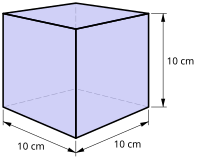
Back Liter Afrikaans Liter ALS Litro AN لتر Arabic إيطرو ARY ليتر ARZ লিটাৰ Assamese Llitru AST Litr Azerbaijani لیتر AZB
| litre | |
|---|---|
 One litre is equal to the volume of a cubic decimetre. | |
| General information | |
| Unit system | Non-SI unit accepted for use with SI |
| Unit of | volume |
| Symbol | L, l[1] |
| Named after | litron |
| Conversions | |
| 1 L in ... | ... is equal to ... |
| SI base unit | 10−3 m3 |
| U.S. customary | ≈ 0.264 gallon |

The litre (British English spelling) or liter (American English spelling) (SI symbols L and l,[1] other symbol used: ℓ) is a metric unit of volume. It is equal to 1 cubic decimetre (dm3), 1000 cubic centimetres (cm3) or 0.001 cubic metres (m3). A cubic decimetre (or litre) occupies a volume of 10 cm × 10 cm × 10 cm (see figure) and is thus equal to one-thousandth of a cubic metre.
The original French metric system used the litre as a base unit. The word litre is derived from an older French unit, the litron, whose name came from Byzantine Greek—where it was a unit of weight, not volume[2]—via Late Medieval Latin, and which equalled approximately 0.831 litres. The litre was also used in several subsequent versions of the metric system and is accepted for use with the SI,[3] although not an SI unit—the SI unit of volume is the cubic metre (m3). The spelling used by the International Bureau of Weights and Measures is "litre",[3] a spelling which is shared by most English-speaking countries. The spelling "liter" is predominantly used in American English.[a]
One litre of liquid water has a mass of almost exactly one kilogram, because the kilogram was originally defined in 1795 as the mass of one cubic decimetre of water at the temperature of melting ice (0 °C).[4] Subsequent redefinitions of the metre and kilogram mean that this relationship is no longer exact.[5]
- ^ a b International Bureau of Weights and Measures (2006), The International System of Units (SI) (PDF) (8th ed.), p. 124, ISBN 92-822-2213-6, archived (PDF) from the original on 4 June 2021, retrieved 16 December 2021.
- ^ Collins English Dictionary.[full citation needed]
- ^ a b Bureau International des Poids et Mesures, 2006, p. 124. ("Days" and "hours" are examples of other non-SI units that SI accepts.)
- ^ Cite error: The named reference
decreewas invoked but never defined (see the help page). - ^ Cite error: The named reference
nist2000was invoked but never defined (see the help page).
Cite error: There are <ref group=lower-alpha> tags or {{efn}} templates on this page, but the references will not show without a {{reflist|group=lower-alpha}} template or {{notelist}} template (see the help page).
© MMXXIII Rich X Search. We shall prevail. All rights reserved. Rich X Search